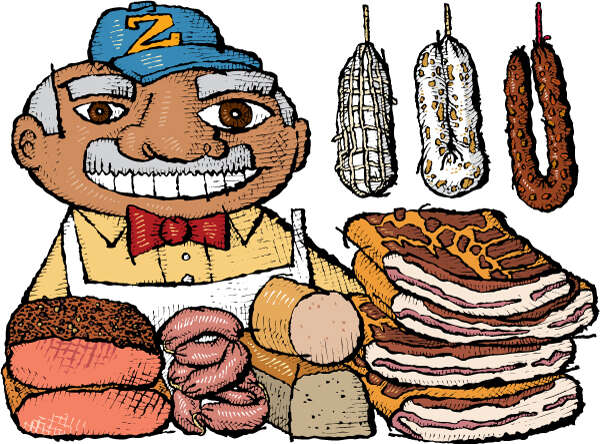People have been curing meats for millennia. For most of that time, no one understood the chemistry behind the process. But for centuries before refrigeration was invented, even if folks didn’t know why curing worked, they knew that once it was done—a process that could take a few weeks to a few years, depending on the size of the cut and the style of curing—the cured meats would keep for months on end. In the 20th century, amid the discovery of vitamins and preservatives and all sorts of food technology advances, scientists figured out the principles that made cured meats possible. In the process, they found shortcuts—and later on, other scientists discovered that maybe those shortcuts weren’t so great after all.
Here’s a summary of how it all works in a brief voyage through high school chemistry, with apologies to mad scientists if I get any of the specifics incorrect.
To make a salami, sodium nitrate, NaNO3 is added to the meat and seasonings before they’re stuffed into the mostly air-proof casing. Inside, the bacteria and microbial organisms live in an anaerobic environment—no oxygen.
Their activity sucks one of the three oxygen molecules away, turning sodium nitrate into sodium nitrite, NaNO2. Sodium nitrite is unstable and aggressive to microbes. It’s the compound that does the real work of curing, making the salami safe for us to eat.
While it does its job, the sodium and another oxygen molecule is leeched off. What’s left is nitric oxide, NO. This fixes the pigment color, keeping salami red. This molecule is safe.
Even though we started the cure with NaNO3 we ended up with NO. A salami maker may add 150 parts per million of sodium nitrate to start the cure, but only 2 or 3 PPM are left. The traditional thirty day curing process eliminates the substance.
So if cured salami doesn’t have any sodium nitrate or nitrite left, why are people afraid of it?
While traditionally cured meat doesn’t have any sodium nitrate/nitrite, non-traditionally cured meat may. During the middle of the last century, in between inventing Twinkies and Cheez Whiz, food scientists deciphered the chemistry that I just described. The scientists correctly identified sodium nitrite (NaNO2) as the money molecule. It did the majority of the curing work. NaNO3 didn’t seem to do much, so they experimented with adding NO2 directly to the meat, cutting NO33 out of the game. It worked. It saved time. Meat could be cured almost overnight. It could go to stores faster. It was a huge success.
Sort of. The problem is when the cure is rushed, the nitrite, NO2, doesn’t disappear like it does when you cure traditionally over thirty days. It’s still present in the meat. NO2 is a carcinogen.
That’s the reason people worry about nitrate cured salami and bacon. Meats may be cured with sodium nitrite—not nitrate—and rushed to market when the nitrite carcinogen is still present. This isn’t true for the cured meats we carry.
What about the “no nitrate” meat at supermarkets?
Nitrates are necessary for curing meat. You can’t cure without them and keep meat pink and safe. But if nitrates are necessary for curing meat, how can places like Whole Foods carry meats they say are nitrate free?
The trick is celery. It’s high in nitrates. Concentrated celery juice is used in the curing, instead of the naturally occurring mineral sodium nitrate. The FDA allows it to be called “Natural Flavor” instead of “Sodium Nitrate.” The words may be different, but the chemistry behind it is the same.
You can taste both curing methods for yourself by frying up the two bacons from Nueske’s. The classic Applewood Smoked is slowly cured with traditional mineral nitrates. The Cherrywood Smoked is labeled “uncured” because it’s made with celery juice.

